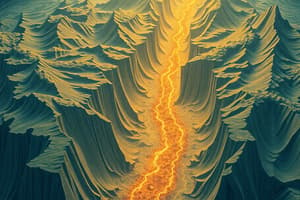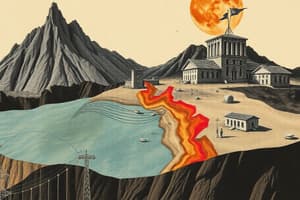Podcast
Questions and Answers
What is the purpose of a seismograph?
What is the purpose of a seismograph?
- To stop earthquakes from happening
- To create destructive seismic waves
- To predict when earthquakes will occur
- To measure earthquakes and record details about their timing and strength (correct)
What are tectonic plates?
What are tectonic plates?
- The parts of Earth's crust that fit together like a puzzle and are constantly moving (correct)
- Seismic waves that shake the earth's crust
- Large machines used by geologists
- Locations where earthquakes occur
What is the location on Earth's surface where a fault can be seen called?
What is the location on Earth's surface where a fault can be seen called?
- Mainshock
- Seismograph
- Aftershock
- Fault line (correct)
Why are geologists unable to predict when earthquakes will occur?
Why are geologists unable to predict when earthquakes will occur?
What happens when two tectonic plates suddenly slip along a fault?
What happens when two tectonic plates suddenly slip along a fault?
What is the definition of a foreshock?
What is the definition of a foreshock?
How are foreshocks different from aftershocks?
How are foreshocks different from aftershocks?
What causes aftershocks to occur?
What causes aftershocks to occur?
How long can aftershocks last?
How long can aftershocks last?
What happens if an aftershock is stronger than the mainshock?
What happens if an aftershock is stronger than the mainshock?
Flashcards are hidden until you start studying
Study Notes
Seismographs and Earthquakes
- A seismograph measures seismic waves generated by earthquakes, recording the ground motion caused by the waves.
Tectonic Plates
- Tectonic plates are large, rigid slabs of the Earth's lithosphere that fit together like a jigsaw puzzle.
Faults
- The location on Earth's surface where a fault can be seen is called a fault trace.
Earthquake Prediction
- Geologists are unable to predict when earthquakes will occur because the complex processes leading up to an earthquake are not yet fully understood.
Earthquake Occurrence
- When two tectonic plates suddenly slip along a fault, they release energy in the form of seismic waves, causing an earthquake.
Foreshocks and Aftershocks
- A foreshock is a smaller earthquake that occurs before a larger earthquake (mainshock).
- Foreshocks are different from aftershocks in that they occur before the mainshock, whereas aftershocks occur after the mainshock.
- Aftershocks are caused by the continuing adjustment of the Earth's crust after the mainshock.
- Aftershocks can last for days, weeks, months, or even years after the mainshock.
- If an aftershock is stronger than the mainshock, it becomes the new mainshock, and the original mainshock is reclassified as a foreshock.
Studying That Suits You
Use AI to generate personalized quizzes and flashcards to suit your learning preferences.




